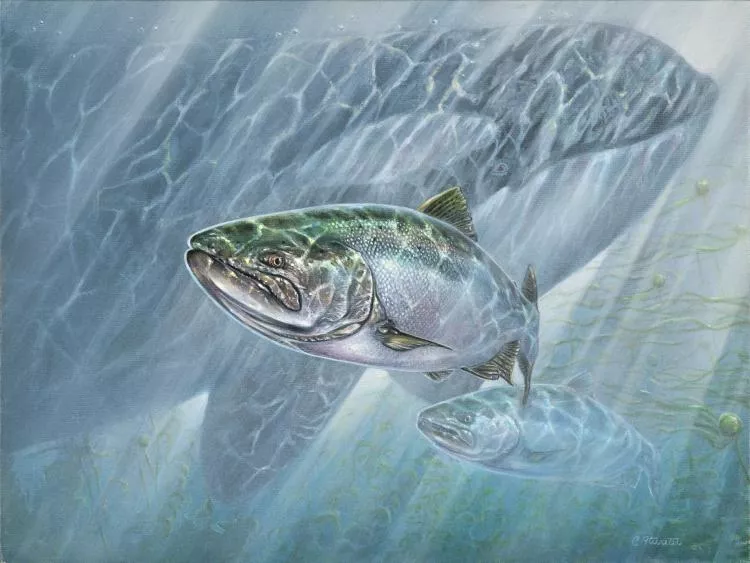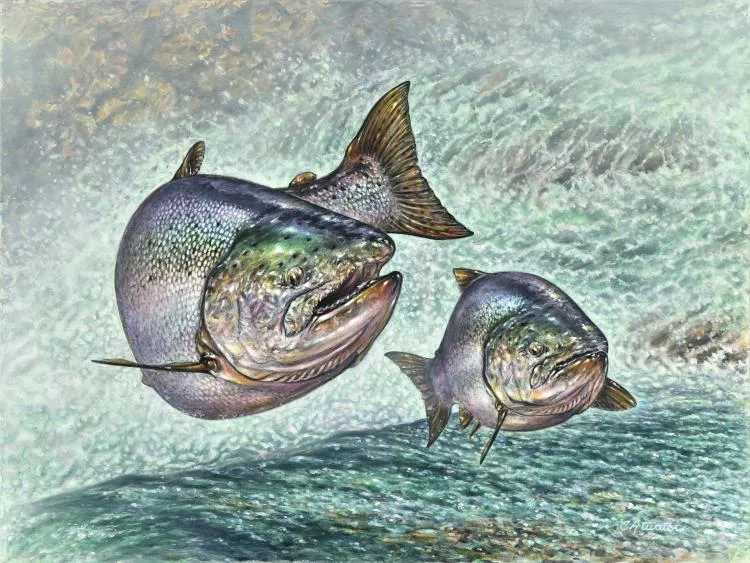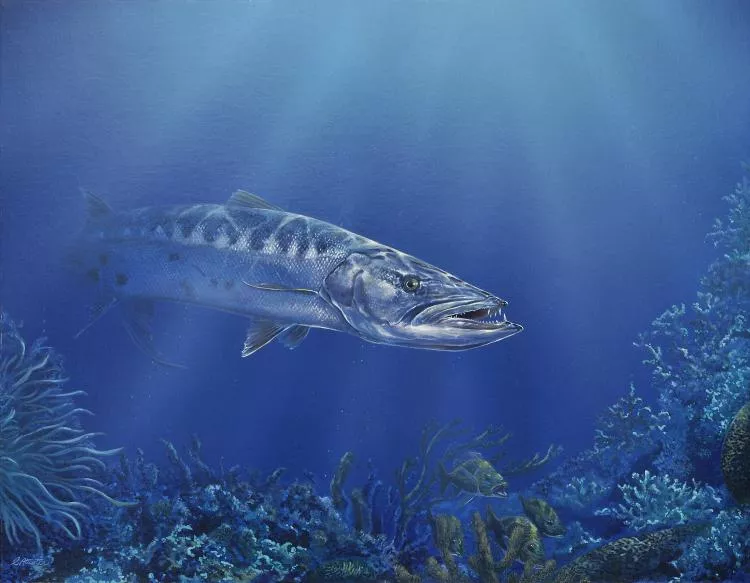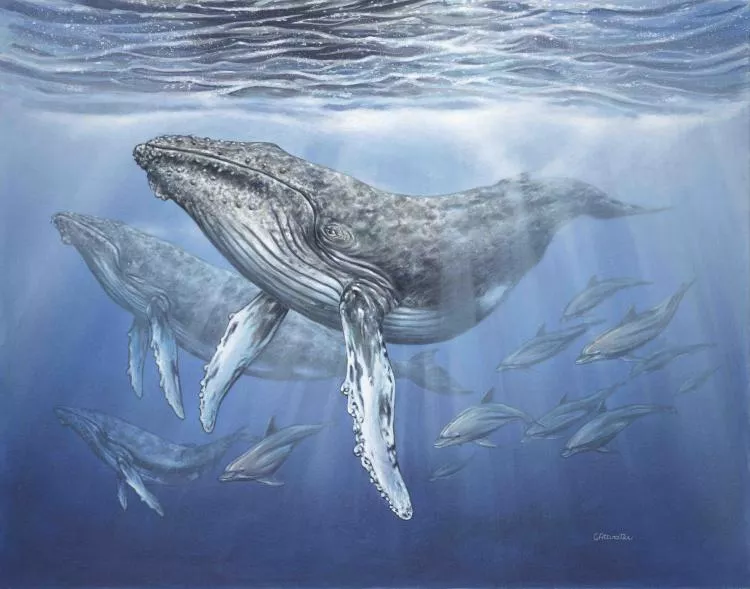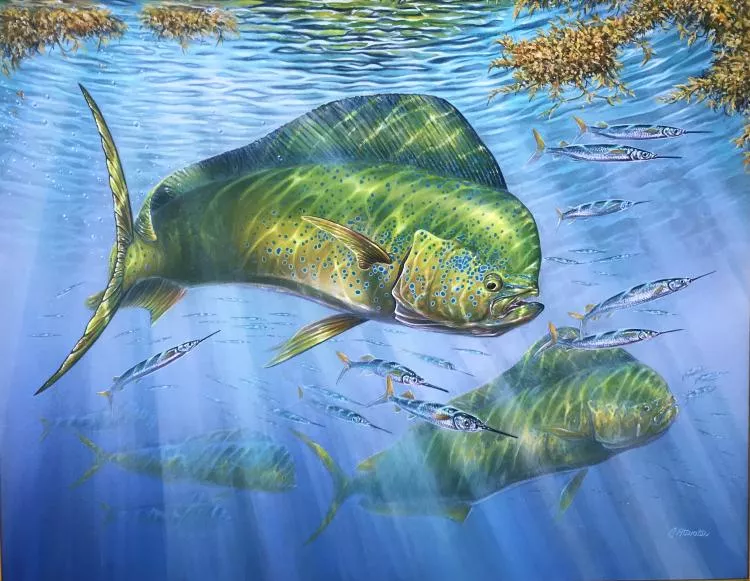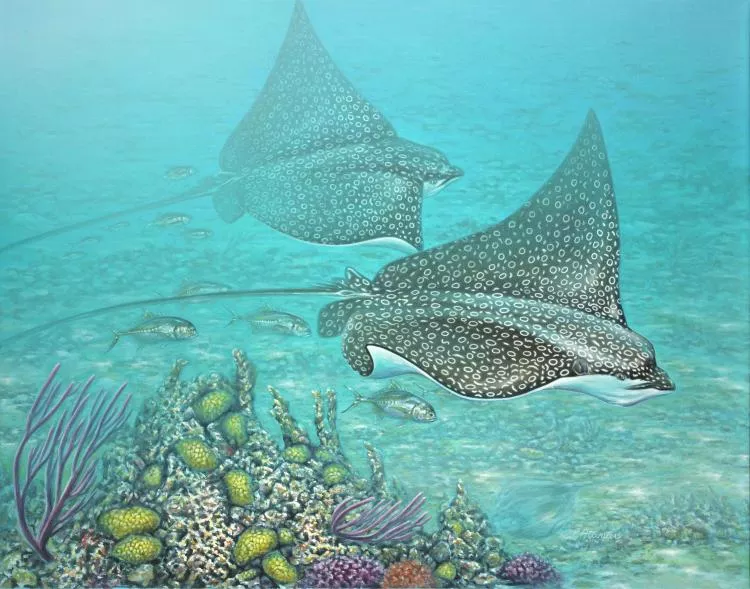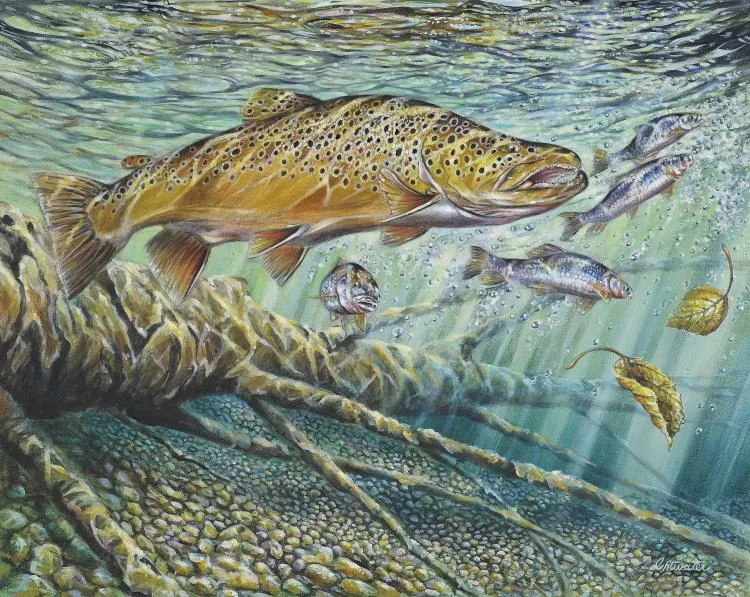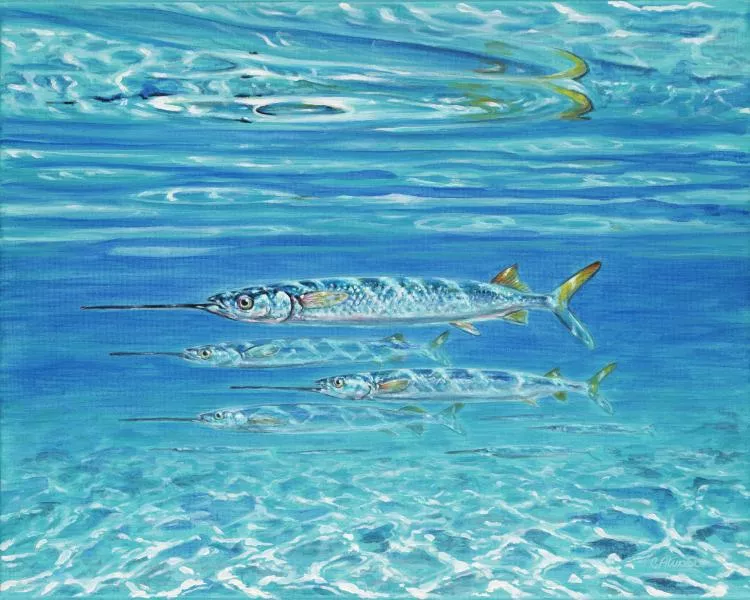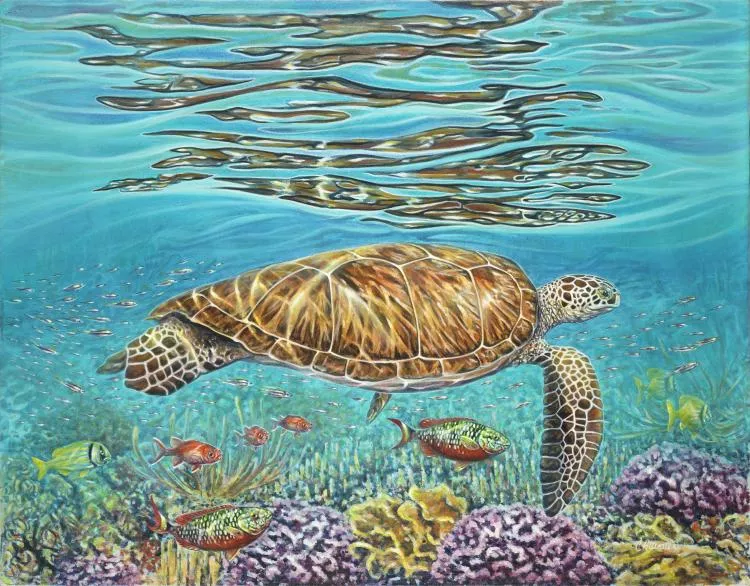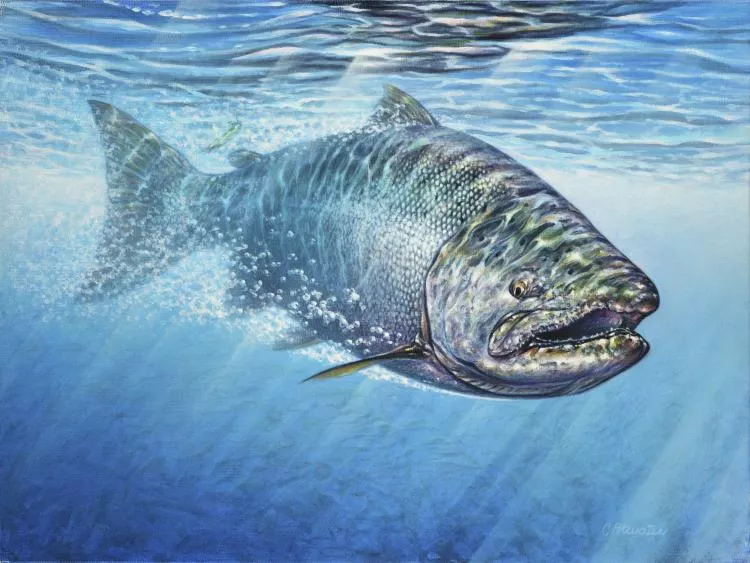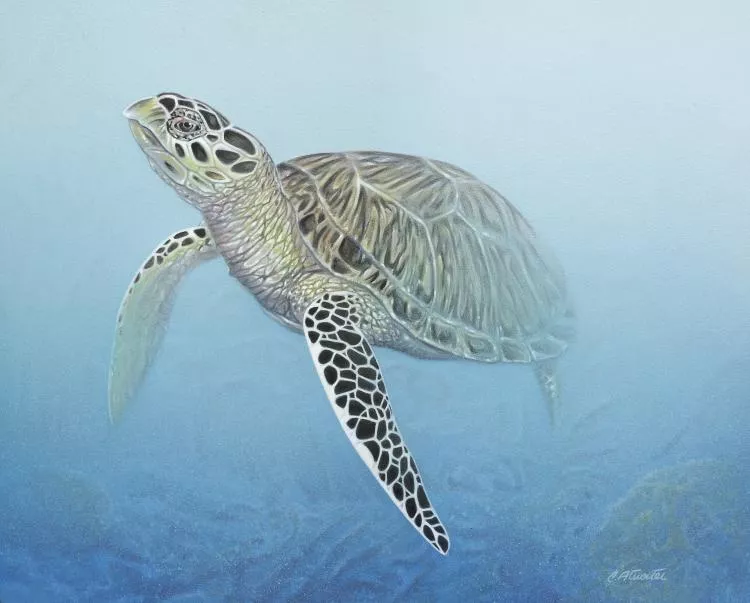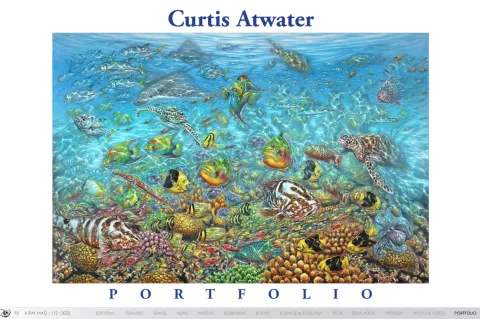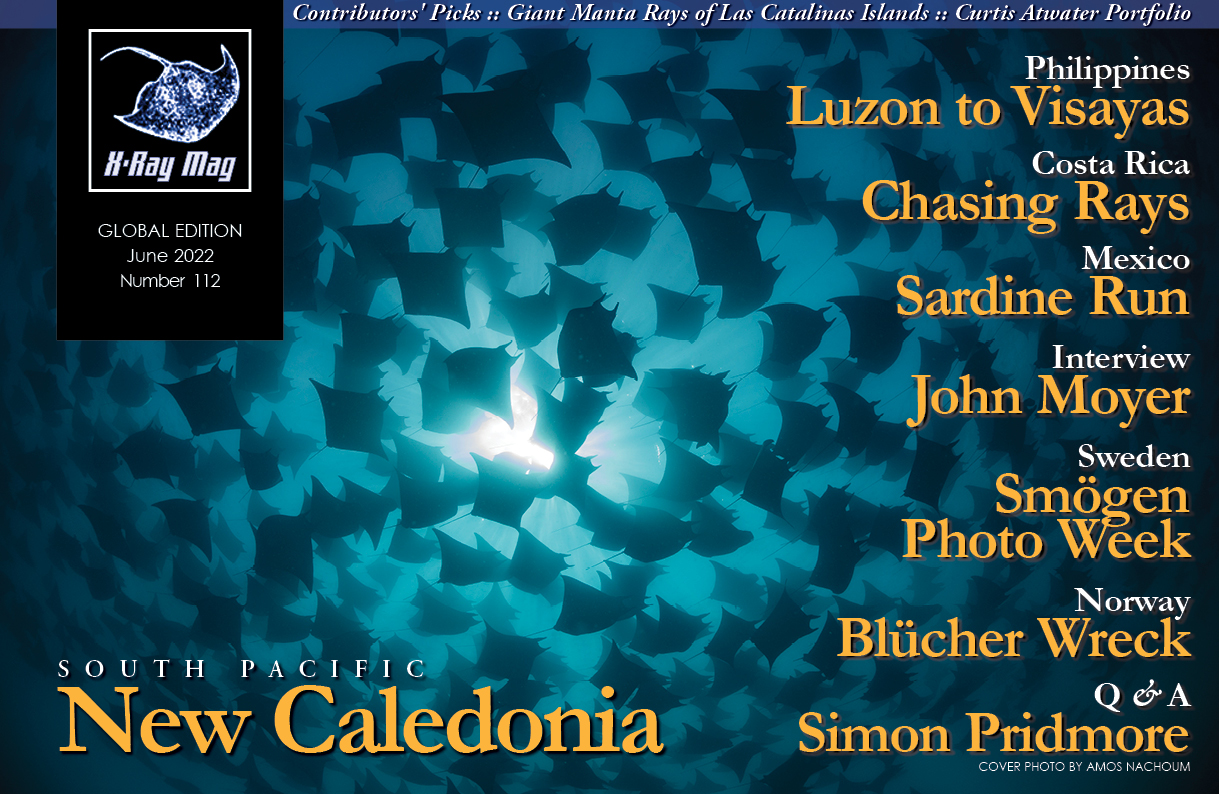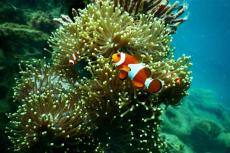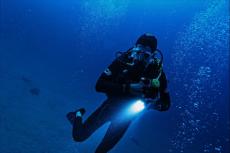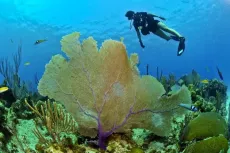Canadian artist Curtis Atwater creates beautiful paintings of marine life and underwater scenes that capture the light and dynamic motion of species under the waves. X-Ray Mag interviewed the artist to learn more about his creative process and perspectives.
Contributed by
X-RAY MAG: Tell us about yourself, your background and how you became an artist.
CA: I have always had an interest in art. I had studied advertising and graphic design before entering the workforce and worked in various facets, including newspaper layout, political cartoons, illustration and cartoon city maps. I eventually transitioned to sales and marketing, while keeping art as a hobby and part-time business.
Being from Canada, I was able to spend much of my free time fishing and snorkelling our northern lakes and Great Lakes and, believe me, there are a lot of lakes in Canada to choose from. I have spent most of my on-water fishing time in Ontario, Vancouver Island, British Columbia coast, Nova Scotia, Turks and Caicos, Cuba, Florida, Costa Rica and Mexico, where I combine fresh and saltwater experiences.
I enjoy painting both underwater scenes and terrestrial wildlife; in this way, I can mix it up a little to avoid boredom of any one subject matter.
X-RAY MAG: Why marine life and underwater themes and how did you develop your style of painting?
CA: I worked mainly in the fishing and boating industry in Canada and the United States, which fit perfectly with my passion for angling. Spending much of my free time on the water fishing, I put the two hobbies together and started drawing and painting underwater scenes.
I originally concentrated on North American freshwater species across Canada and then started travelling to the Caribbean a lot and developed a keen interest in the diversity of the coral reef ecosystem. A lot of time was spent snorkelling and fishing in the Turks and Caicos Islands where I photographed and filmed the vibrant underwater life of the area.
I do not use elaborate underwater camera systems for research. I mostly take my small Sony Cyber-shot DSC-TX30 or my GoPro Hero3 for quick access and spontaneous shots.
X-RAY MAG: Who or what has inspired you and your artwork and why?
CA: When I started actively painting, it was around the same time Robert Bateman was becoming extremely popular as the leading nature artist, and I became a keen fan of his work. His uncanny feel for design is what I most respect. I would say a lot of my techniques came from purchasing and reading his books.
I have also greatly admired and definitely been influenced by some of the premier underwater artists like Stanley Meltzoff with his bold brushstrokes, Mark Susinno with his keen ability to depict natural lighting and underwater surface effects, and Larry Tople with his knack for creating action in his freshwater fishing scenes.
X-RAY MAG: What is your artistic method or creative process?
CA: I mostly use soft body acrylic paint and tend to water them down in baby food jars to apply multiple washes to my work until I get the results I want. I found acrylics a fast, forgiving medium that fit my lifestyle when I was juggling art and full-time work. Sometimes, I go to hard body acrylics or water-based oils for a bold effect.
Originally, I used Masonite board and applied multiple layers of gesso, which created a smooth surface for detailed work. Now, I have a tendency to use pre-gesso canvas and boards—probably just becoming lazy these days.
My painting begins with the idea, then many sketches using mostly photographs I have taken and collected as reference. I then proceed to transfer the final sketched image to the board, and away I go, not always sure what will eventually happen.
X-RAY MAG: What is your relationship to the underwater world and coral reefs? How have your experiences underwater influenced your art? In your relationship with reefs and the sea, where have you had your favourite experiences?
CA: Unfortunately, inner ear issues prevented me from pursuing scuba diving, so I concentrated on snorkelling as my main underwater activity. It is also an excellent family activity.
The underwater world of the Turks and Caicos Islands, where I snorkel, is full of eagle rays, turtles and barracudas, to name a few, and I enjoy hanging with these folks as much as possible. The grace and beauty of these species never gets old, and just watching them is my biggest artistic influence.
I have never had any issues with any species, including sharks, but great barracudas can sometimes be hard to read. Most ignore you or slowly swim away, but I have had a few that rush toward me and seem to veer away at the last minute, sometimes following right back close to shore. I am assuming these are territorial reactions or cases of mistaken identity.
X-RAY MAG: What are your thoughts on ocean conservation and coral reef management and how does your artwork relate to these issues?
CA: I would assume I am the same as anyone, in that I am all for cleaning up the oceans. The coral reefs I visit are certainly not what they were 20 years ago. When I recently visited South Asia, I could not believe the amounts of discarded plastic in the rivers and oceans in some areas.
Most reference material is gained through underwater photography and fishing when possible. I randomly photograph everything that I find interesting, including any fish species, coral varieties, plants, surface shots and different lighting effects—whatever might work for future paintings. I usually tape a multitude of photos over my artboard to use as reference for a painting.
X-RAY MAG: What is the message or experience you want viewers of your artwork to have or understand?
CA: I do not really have any message being portrayed through my work. It is all done for enjoyment. If people view my work and they like it, then fantastic; if not, no big deal.
X-RAY MAG: What are the challenges or benefits of being an artist in the world today? Any thoughts or advice for aspiring artists in ocean arts?
CA: I would have to think it is a tough go, being a full-time artist. This is why I found it necessary to have a full-time job and use art as a hobby and part-time occupation. I did try the freelance artist route, but found I had to take projects I really did not enjoy just to pay the bills. There are some extremely talented artists out there, and they may find a niche that works.
As far as advice, I would have to say: try and paint what you have a passion for, if this is possible.
X-RAY MAG: How do people—adults and children—respond to your works?
CA: Some people like my work, and some do not. I have not done many shows in quite a while, so have not had much direct contact recently to elaborate on.
X-RAY MAG: What are your upcoming projects, art courses or events?
CA: I plan to continue painting more below and above water life, using this interest as an excuse to further my travels to many additional Caribbean locations and take a journey through Indonesia and Australia, spending as much time as possible along the Great Barrier Reef.
X-RAY MAG: Lastly, is there anything else you would like to tell our readers about yourself and your artwork?
CA: I have been able to work on a lot of great projects and met many great people through my artistic ventures. I have had my work featured on provincial stamps through the Pacific Salmon Foundation for the province of British Columbia, Canada, and the Ontario Federation of Anglers and Hunters, collector coins through the Royal Canadian Mint of Atlantic salmon, sockeye salmon and Arctic char and a four-coin collection of Canadian freshwater fish, and many magazine and book covers in North America and Europe.
In addition, I have published many limited edition prints of freshwater game fish and wildlife of North America, so I would say it has been quite a satisfying pursuit so far. Some of my paintings can be viewed through the Artists for Conservation website.
For more information or to purchase artwork, please visit the artist’s webpage at: artistsforconservation.org/artists/1249

